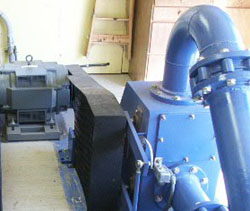Major Components of a Hydro System
Bookmark this page (Ctrl+D)
![]() View/Print PDF Version
View/Print PDF Version
Guide Navigation
The Drive System and Generator
Drive System
The drive system couples the turbine to the generator. At one end, it allows the turbine to spin at its optimum RPM. At the other, it drives the generator at the RPM that produces correct voltage and frequency.
The most efficient and reliable drive system is a direct, 1:1 coupling between the turbine and generator. This is possible for many sites, but not for all Head and Flow combinations. In many situations it is necessary to adjust the transfer ratio so that both turbine and generator run at their optimum, but different, speeds.

Belt drive coupling between turbine and generator.
These types of drive systems can use either gears, or pulley and belts, all of which introduce additional efficiency losses into the system. Belt systems tend to be more popular because of their lower cost. Your turbine manufacturer can provide valuable guidance about matching turbine and generator RPM, and suggest options if a direct, 1:1 coupling is not possible.
Generator
The generator converts the rotational power from the turbine shaft into electrical power. Efficiency is important at this stage too, but most modern, well-built generators deliver good efficiency.
There can be big differences in the type of power generated, however. DC (Direct Current) generators can be used with very small systems, but typically are augmented with batteries and inverters for converting the power into the AC (Alternating Current) power required by most appliances.
AC generators are normally used in all but the smallest systems. Common household units generate 120VAC (volts AC) and 240VAC, which can be used directly for appliances, heaters, lights, etc. AC voltage is also easily changed using transformers, which makes it relatively simple to drive other types of devices or transmit over long distances. Depending on your power requirements, you can choose either single-phase or three-phase AC generators in a variety of voltages.
One critical aspect of AC power is frequency, typically measured as cycles per second (cps) or Hertz (Hz). Most household appliances and motors run on either 50Hz or 60Hz (depending on where you are in the world), as do the major grids that interconnect large power generating stations. Frequency is determined by the rotational speed of the generator shaft; faster rotation generates a higher frequency.